Asil chicken
The Asil or Aseel is a breed of chicken originating from Indian subcontinent
It is famous in Indian states of Andhra Pradesh and Tamil nadu and in Pakistan’s Punjab area. In general this Fowl is found throughout Southeast Asia, such as Shamo and Thai Game. The breed is generally unstandardised in South Asia and India, but popularity has increased in the western world in recent times with the breed standardised in the British,[1] Australian[2] and American standards.[3]
Description and history
Asils were first used for cock fighting and may be considered fighting cocks. Aseel is noted for its pugnacity. The chicks often fight when they are just a few weeks old and mature roosters will fight to the death. Hens can also be very aggressive towards each other.
Towards humans Asil are generally very tame and trusting. There are anecdotes where they have come to their keepers for other things than food, for example to get the keeper to open the door to the coop so they can get to roost.[4]
The hens are not good layers, but are excellent sitters. Laying depends on the Asil variety, the small Asil are known to be very poor layers, sometimes laying just 6 eggs a year, whereas larger Asil can lay around 40 eggs a year.
In the U.S., the breed is on the "Watchlist" (2012), by the Livestock Conservancy.[5] The Aseel breed is found in almost all states of India, but abundant in Andhra Pradesh and Tamil Nadu.
Classification
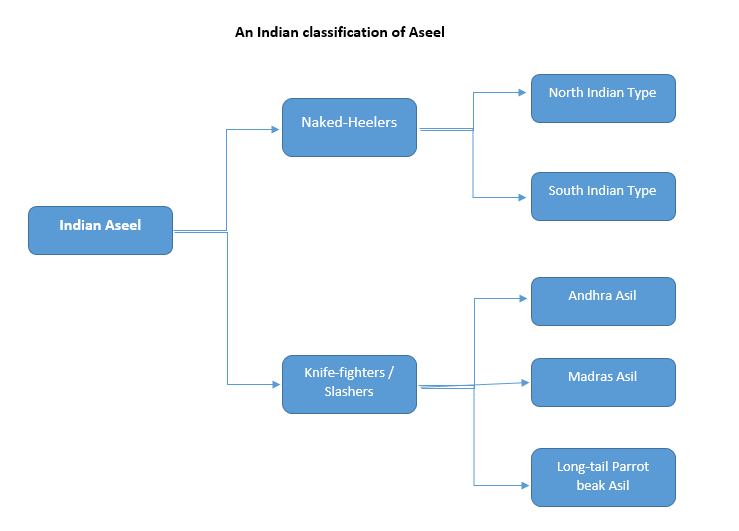
Varieties
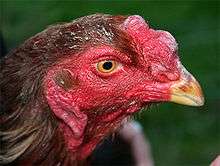
There are many varieties of Asil, some are standardized for shows such as the Reza Asil in the UK, some are simply named after the area where they are bred such as the Mianwali Asil from Pakistan or the colour, red/wheaten Asil are generally known as "Sonatol".
There are also hen-feathered Asil knows as "Madaroo" these are found in various colours, but the cocks come with feathers in hen colour, don't have sickle feathers in the tails and miss the large hanging feathers on the saddle. This variety is very rare.
Asil with feather beards under their beaks known as "muffed" and with tufts on the top of their heads known as "tasseled" are also seen, but are very rare especially outside India/Pakistan.
Bhaingam Asil variety have a large single comb but confirm to all the other Asil standards.
Broadly speaking, Asil in Europe are categorized and shown under these three types:
Madras Aseel
(Tamil local name: Kathikal peruvedai) This is a heavy type of Aseel found in the erstwhile Madras province. The body type and colour classification are same as that of long-tail parrot beak Aseel. They have a normal tail and nose unlike longtail parrot beak Aseel. They are used for knife fighting. They are predominantly found in Tamil Nadu.
Kilimookku Aseel (Parrot Beak/Nose Long Tail)
_from_Alanganallur%2C_Madurai.jpg)
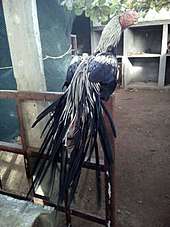
(Tamil local name : Kilimooku visirival peruvedai)
Long Tail Parrot Beak Aseel is an[6] Aseel Breed available only in the southern part of India especially in Tamil Nadu. Although they were used as fight birds in the past, today they are prized for their ornamental value.These Aseels are huge and muscular in appearance much like body builders, possess long tails with beaks very short and thick similar to that of a Parrot hence the name kilimookku meaning parrot beak. Particularly noted is their warrior like gait and the proud attitude. In English they are called Long Tail Parrot Beak/Nose Aseels. These birds are coveted and desired by any Aseel enthusiast.
The birds are generally categorised based on their physique and colour combinations some of which are:
- Mayil Karuppu (black and yellow)
- Kagam/sengaruppu (black and red)
- Sevalai (red)
- Karum Keeri/Senkeeri (black/red dotted)
- Sambal Boothi (grey)
- Kokku Vellai (white)
- Noolan (white and black)
- Pondram (golden brown)
An average one-year old Kilimookku Aseel weighs at about 5 kg and will go on to weigh up to 7 kg when full grown. These Aseels were exported to China and Thailand in the early days but the exports have now been banned. However people from all over the world come for the eggs of these majestic birds. The average life span of these Aseels are from 5 to 8 years although birds that are 10 years old are not uncommon.
The number of breeders have risen due to the rising demand and the birds command a premium. Prices range anywhere from INR 7000 to INR 150000 depending on colour, length, spread and consistency of the tail, thickness and curve of the beak, shape of the head and overall physique and size of the bird.
Breeding is selectively done and breeders have prided in their breeds in the villages of south Tamil Nadu for centuries. Madurai, Alanganallur, Dindigul, Trichy, Palani, Udumalai, Pollachi, Salem, Namakkal are the major geographical belts where this particular breed is spotted. Breeders have over the centuries established their own breed lines of the parrot beak Aseel that replicate certain characteristics in appearance over several generations.
The main registered clubs of these Aseel breeders are:
- All India Aseel Organisation - AIAO
- Tamilnadu Aseel Organisation -TAO (AYYALUR)
- Dindigul Aseel Breeders Association
- Indian Aseel Breeders Association Palani
- Trichy Aseel Breeders Association Trichy
Every member of these clubs are well known breeders in their home towns.
Every year these clubs conduct Aseel exhibitions where people from all over India showcase their Aseels with passion and pride and the rare Kilimookku (parrot beak/nose long tail) Aseels rules the roost.
Reza Asil
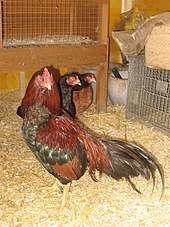
Height: exactly Up to 14.5 inches tall up to shoulder button. Weight: Maximum weight for the hens is 1.8 kg, max weight for the cocks is 2.7 to 3 kg.
This type is standardized by the Asian Hardfeather Society in the UK and is seen at shows throughout the UK, but is quite rare.
This group of Asil reached worldwide popularity due to books and articles written by gamefowl experts such as Herbert Atkinson, Siran and Paul Deraniyagala from Sri Lanka and Carlos Finsterbusch from Chile. The Reza Asil family according to the old (Western) gamefowl literature is subdivided into following strains: (Amir) Ghan (Dark-Red), Sonatol (Light-Red), (Siyah) Rampur (Black), Kalkatiya (Kaptan) (Speckled-Reds) and Jawa (Duckwing). All these strains are identified by their specific colour, these colours do not necessarily correspond with the area where the birds come from.
In colonial times other colours such as whites, spangles, golden, etc. were regarded as inferior. At present day the "classic" strains and names given mentioned by Atkinson are more or less forgotten. The native people in India, Pakistan, Bangladesh and Sri Lanka only know the Reza-type Asil by their local names.
Kulang Asil
Height: Up to 75 cm tall. Weight: 5 to 7 kg.
The large Asil are divided into sub-varieties: North Indian, South Indian and Madras type. The North and South Indian varieties do not differ much. Only type of comb, shape of the beak and body shape are different. For example: Northern type = slender, Southern type = heavier build. The Madras Asil however is significantly different. They have a lower station, are heavier build and stronger boned. These birds often come in a bluish colour. This variety is found in the deep south of India, the Tamil Nadu state.
Sindhi Aseel
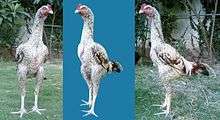
Sindhi Aseel or Sindhi Asil (Sindhi: سنڌي اسيل, Urdu: سندهي اسيل) is a breed of chicken and as from the name, originates from Sindh (one of four major provinces of Pakistan). These cocks, or fighting cocks, are noted being tall, heavy and good at fighting, so they are bred mainly for cockpit. These Aseels are characterised by a muscular but compact body, broad shoulders, wings carried against the body, short and hard feathers, drooping tails, a large curved beak similar to that of an eagle, pea comb and no wattles.
Mianwali
This breed is mainly found in Mianwali district of Pakistan. However, since its arrival, this breed has risen to popularity in Pakistan, currently the primary game breed used in the pits also preferred by gamblers. It is smaller compared to Sindhi Aseels weighing between 1.5 and 3.5 kg depending on the preference of breeders. It is much faster and a better head hitter usually comes in small to medium height. A good Mianwali Aseel should kill its opponent within a few minutes. They have been known to kill bigger roosters because of their speed and accuracy. They come in various colours such as Java (duckwing), Lakha (reddish), black and various others depending on the combination used in breeding. Very hard and a brave fighter with attitude to inspire, excellent in naked heels and metal spurs. There are many sub breeds of this breed owing to the combination used in breeding. A good tested Mianwali rooster would usually have offspring of a similar quality. Typical description would be small curved beak, strong joints, pearl/white/yellow eye colour, short crow, small comb and do not have heavy body structure. May look smaller than other breeds but is excellent spurer.
Amroha
Origin This is a rare and very contested breed of Aseel used in Pakistan and India. While originating in the Amroha state of India the evidence of this breed in India remains precarious today. Very few of these roosters exist in their pure form even in Pakistan where various groups of Aseel breeders tend to associate it with Peer Shah Alam Shah of Mianwali.
Physiological characteristics They are known to be small to medium like Mianwali. Glossy and hard feathered Amroha Aseels are known for their geometrically round physical traits. The shape of their face is round with a strong beak itself round to some extent. The jaw bone on their face is slightly uplifted and eyes are human like slightly closed and narrow with prominent eyebrows. Another usual characteristic is their thick round neck slightly uplifted in cobra snake position especially when they are held in hand. Their colour is usually black breasted red or black breasted dark brown (colour of dates). Another characteristic perhaps due to heavy inbreeding consists in the small size of their legs and feet. Usually they have a very small length of their feet about 3 cm maximum with small feet . As to their weight people make different claims usually in their pure form they are small but heavy with thick bone structure (Like Pit-bull dog ) reaching 2 kg weight depending upon the feed. Their tails and wings have white feathers. Amroha Aseels are very beautiful to look at. They are more talkative and produce more noise than other Aseels.
Hatching Amroha hens would hatch 9 to 12 eggs which they lay in the month of March to April and usually in September as well. A successful hatch will keep the Amroha hen busy for at least six months sometimes even up till the male chicks start crowing. They will often hatch identical to their parents.
Bantam Asil
Weight: Up to 0.75 kg.
Bantam Asil have been created at the end of the 19th century by an English breeder named William Flamank Entwisle. The breed got very popular after its creation but after a couple of decades interest in this variety slowly died out. Until the beginning of the 1980s nothing was heard about these little Asil. A Belgian breeder named Willy Coppens created them again using Shamo (chicken), Indian Game and Reza Asil. The breed was also introduced again in the Netherlands and United Kingdom. At present day Bantam Asil are quite popular and they are bred in various colours.
Lasani Aseel breed
Pakistani Aseel breeders have developed different varieties of Aseel/Asil breeds. But one of the rarest breed is what they call Lassani Aseel breed. They are medium size birds with powerful strikes to earn them the title of "Neck Breakers". This breed has a typical parrot like beak and small neck size. Unlike Mianwali they have a particular fight style. They don't like jumping over the opponent rather they like to come closer to the opponent touching him with their front body and than attacking on the neck. So in a typical Mianwali versus Lassani fight you will see Mianwali birds dominating initially but as soon as they are tired of jumping around and land on the ground somewhat tired lasani breed cock will finish the game with a couple of hits in the neck. Amroha and lassani are closely related however lassani breeds have smaller necks and often closed eyes only few families of Nawab have got this breed in its pure form. And the notion that they are bengam type Aseels/Asils is mistaken.[7]
References
- British Poultry Standards. Blackwell Publishing. 2008. p. 47.
- Australian Poultry Standards. Victorian Poultry Fanciers Association Ltd trading as Poultry Stud Breeders and Exhibitors Victoria. 2012. p. 188.
- "APA Recognized Breeds and Varieties" (PDF). American Poultry Association. Archived from the original (PDF) on 2017-11-04. Retrieved 18 January 2013.
- The game fowl colours, Owen Dickey, privately published
- "The Livestock Conservancy". The Livestock Conservancy. Retrieved 2014-04-29.
- Owner, Global Asil Club (2011-11-23). "The Global Asil Club: The Asils - Home". The Global Asil Club. Retrieved 2018-01-19.
- "Asils Home - Andhraasil". Andhraasil.webs.com. Archived from the original on 2014-05-31. Retrieved 2014-04-29.
- Oriental Gamefowl, Horst W. Schmudde, Authorhouse, ISBN 1-4208-7681-3
- The complete encyclopedia of chickens, Esther Verhoef & Aad Rijs, Rebo International, ISBN 90-366-1592-5
- "The Aseel (or Asil)". The Society for the Preservation of Poultry Antiquities.
- "Aseel". mypetchicken.com.
- "International World of Asil". Archived from the original on 2010-01-11.